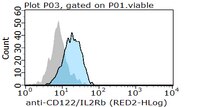Immunology
Shi, Z; Rifa'i, M; Lee, YH; Shiku, H; Isobe, K; Suzuki, H
Immunology
124
121-8
2008
Pokaż streszczenie
CD8+CD122+ regulatory T cells are a newly identified, naturally occurring type of regulatory T cell that produce interleukin-10 (IL-10) and effectively suppress interferon-gamma (IFN-gamma) production from both CD8+ and CD4+ target cells. Molecular mechanisms responsible for the recognition of target cells by CD8+CD122+ regulatory T cells were investigated in this study by using an in vitro culture system that reconstitutes the regulatory action of these cells. CD8+CD122( regulatory T cells did not produce IL-10 and did not suppress the IFN-gamma production of allogeneic target T cells when they were stimulated by immobilized anti-CD3 antibody alone, but they clearly produced IL-10 and suppressed the IFN-gamma production of target cells when stimulated by anti-CD3 plus anti-CD28-coated beads. IFN-gamma production by major histocompatibility complex-class I-deficient T cells was also suppressed by CD8+CD122+ regulatory T cells stimulated with anti-CD3 plus anti-CD28 antibody but was not suppressed by cells stimulated by anti-CD3 alone. Experiments examining the blockade of cell surface molecules expressed on either the regulatory cells or the target cells by adding specific neutralizing antibodies in the culture indicated that CD80, CD86, and CD28 molecules were involved in the regulatory action, but cytotoxic T lymphocyte antigen-4, inducible costimulatory molecule (ICOS) and programmed death-1 (PD-1) molecules were not. Finally, CD8+CD122+ cells isolated from CD28-knockout (CD28-/-) mice showed no regulatory activity. These results indicate that CD8+CD122(+) regulatory T cells recognize target T cells via the interaction of CD80/CD86-CD28 molecules to become active regulatory cells that produce suppressive factors such as IL-10. | 18205792
 |
The Journal of experimental medicine
Rifa'i, M; Kawamoto, Y; Nakashima, I; Suzuki, H
The Journal of experimental medicine
200
1123-34
2004
Pokaż streszczenie
Regulation of immune system is of paramount importance to prevent immune attacks against self-components. Mice deficient in the interleukin (IL)-2/IL-15 receptor beta chain, CD122, are model animals of such immune attacks and characteristically have a high number of abnormally activated T cells. Here, we show that the transfer of CD8+CD122+ cells into CD122-deficient neonates totally prevented the development of abnormal T cells. Furthermore, recombination activating gene-2-/- mice that received wild-type mice-derived CD8+CD122- cells died within 10 wk after cell transfer, indicating that normal CD8+CD122- cells become dangerously activated T cells in the absence of CD8+CD122+ T cells. CD8+CD122+ cells could control activated CD8+ or CD4+ T cells both in vivo and in vitro. Our results indicate that the CD8+CD122+ population includes naturally occurring CD8+ regulatory T cells that control potentially dangerous T cells. | 15520244
 |









